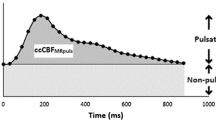Abstract
Electrical impedance plethysmography (EIP) is a noninvasive method that may be useful for both the continuous and serial measurement of changes in pulsatile cerebral blood volume and perhaps cerebral blood flow (CBF). It has not been well validated by comparison with other methods. To attempt to validate the EIP technique, the relationship between the peak amplitude of the transcranial, cardiac-synchronous impedance waveform (dZp) and cerebral blood flow measured by the radiolabelled microsphere technique (CBFrlm) and laser Doppler spectroscopy (CBFrds) was studied in rabbits. CBF was altered by inducing hypertension using metaraminol, hypotension by controlled haemorrhage or hypocarbia by hyperventilation. Twenty-three comparisons between dZp and CBFids and 19 comparisons with CBFrim were made in eight rabbits. The percentage change between each measurement using the three techniques in each animal was calculated. Using pooled data from all the animals, the linear regression equations were dZp=0.5 CBFrim+33 (r=0.38, p=0.22, SE=79) and dZp=0.84 CBFids+19.6 (r=0.46, p=0.09, SE=72). It is concluded that, in the anaesthetised rabbit, when large changes in CBF are induced by the manoeuvres described above, changes in dZp correlate very weakly with changes in either cortical or global CBF, and are influenced by other factors such as pulsatile intracranial blood volume.
Similar content being viewed by others
Abbreviations
- EIP:
-
electrical impedance plethysmography
- CBF:
-
cerebral blood flow
- CBV:
-
cerebral blood volume
- RLM:
-
radiolabelled microsphere
- LDS:
-
laser Doppler spectroscopy
- dZ p :
-
peak amplitude of cardiac synchronous transcephalic impedance waveform
- CBFrim :
-
cerebral blood flow estimated using the radiolabelled microsphere method
- CBFids :
-
cerebral blood flow estimated using the laser Doppler spectroscopy method
References
Chen, R. Y., Fan, F. C., Scheussler, G. B., Simchon, S., Kim, S. andChien, S. (1984) Regional cerebral blood flow and oxygen consumption of the canine brain during hemorrhagic hypotension.Stroke,15, 343–351.
Colditz, P. B. (1988) The cerebral circulation of the newborn studied by electrical impedance plethysmography. D.Phil. thesis, University of Oxford.
Golditz, P., Greisen, G. andPryds, O. (1988a) Comparison of electrical impedance and133Xenon clearance for the assessment of cerebral blood flow in the newborn infant.Pediatr. Res.,24, 461–464.
Colditz, P. B., Pryds, O., Greisen, G., Murphy, D., Rolfe, P. andWilkinson, A. R. (1988b) Cerebral electrical impedance: do indices derived from it provide information on cerebral blood flow in the neonate?Scand. J. Clin. Lab. Invest.,48, 691–696.
Eyre, J. A., Essex, T. J. H., Flecknell, P. A., Bartholomew, P. H. andSinclair, J. I. (1988) A comparison of measurements of cerebral blood flow in the rabbit using laser Doppler spectroscopy and radionuclide labelled microspheres.Clin. Phys. Physiol. Meas.,9, 65–74.
Gould, S. J., Howard, S., Hope, P. L. andReynolds, E. O. R. (1987) Periventricular intraparenchymal cerebral haemorrhage in preterm infants: the role of venous infarction.J. Pathol.,151, 197–202.
Haberl, R. L., Heizer, M. L., Marmarou, A. andEllis, E. F. (1989) laser-Doppler assessment of brain microcirculation: effect of systemic alterations.Am. J. Physiol.,256, H1247-H1254.
Heymann, M. A., Payne, B. D., Hoffman, J. I. andRudolph, A. M. (1977) Blood flow measurements with radionuclide-labelled particles.Progr. Cardiovasc. Dis.,20, 55–79.
Murphy, D. (1987) Developments of the electrical impedance method with application to plethysmography and tomography. D. Phil. thesis, University of Oxford.
Namon, R., Gollan, F. andShimojo, S. (1967) Basic studies in rheoencephalography.Neurology,17, 239–252.
Sato, M., Pawlik, G. andHeiss, W. D. (1984) Comparative studies of regional CNS blood autoregulation and responses to CO2 in the cat. Effects of altering arterial blood pressure and PaCO2 on rCBF of cerebrum, cerebellum and spinal cord.Stroke,15, 91–96.
Author information
Authors and Affiliations
Rights and permissions
About this article
Cite this article
Colditz, P.B., Bartholomew, P.H., Sinclair, J.I. et al. Electrical impedance plethysmography: Its use in studying the cerebral circulation of the rabbit. Med. Biol. Eng. Comput. 31, 39–42 (1993). https://doi.org/10.1007/BF02446883
Received:
Accepted:
Issue Date:
DOI: https://doi.org/10.1007/BF02446883




